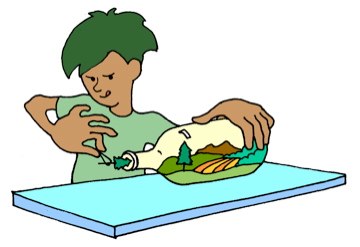Bounding a Model


an appropriate focus
In management practice, the initiative to develop a simulation model usually begins with a problem or concern that is evidently too complicated (too many details) for people to grasp the conjoint implications of the different elements. In academics and research people sometimes build computer models to explore and express their own understanding of complicated (and complex) systems.
The difficulty one encounters when focusing on a problem is that its hard to tell where it ends. Anything can always be seen to be linked to many other things (elements of our world are highly interconnected), hence some arbitrary but defensible boundaries have to be specified. In the practice of Adaptive Environmental Management we developed a procedure to help people clarify the domain of the model.
time - the iteration interval
How often should the model cycle?
Should it be an annual calculation? Some things don’t make sense annually, they may be seasonal; and hence one may need to divide the year into seasons or months. Further dynamics may happen much faster, for example spread of disease, water flows, weather changes. A much shorter interval is required for these.
Time duration and iteration interval need to be considered jointly as a longer duration implies less detail in the calculations.

Without these simple steps people tended to argue about “what we should do” without a good understanding of the system of concern - you likely are aware of such arguments in the news. Getting explicit about what matters, what one can do, and what the consequences of that activity are, through a series of direct effects (as in your Impact Hypotheses) reduces the argument, or at least moves it to more productive arenas. People still disagree on individual relationships, but those can usually be tested. People still disagree on what results they want (what matters), but that can be better negotiated if the conversation on preferences and values is not confounded with the dynamics of the system

actions
If the intent is management, then we should focus on what we can do. What activities, or management practices could we alter, that are likely to influence that which we care about.
indicators
If there is a problem, it is only a problem because something we care about is either increasing (e.g. a pest) or decreasing (e.g. a fish species). What precisely are the indicators (VEC’s) that we would like to use to evaluate whether whatever we want as a result has been achieved?



space
What is the logical extent of the area we want to represent?
Do we want to simulate a square meter of prairie grass or are we concerned about the dynamics of herbivores, hunters, and predators that move over larger areas? Is there a natural boundary like the extent of the grassland, or lake, or management unit? (If it is an institutional or political boundary, then cross-boundary effects become imminent).
Another question is the spatial resolution to consider; can one treat the area as a singular whole or are the spatial effects (hydrological, dispersal etc.) that require spatial disaggregation, and if so how finely. Can the desired resolution be supported by logic and/or data?
(see more about space)
time - projection period
How far into the future do we want to project?
Some dynamics require a long projection to make sense, for example the growth of a forest, especially if one is considering cycles of logging and regrowth.
Yet the further into the future we project, the more likely there will be cumulated errors based on how we have formulated the relationships, and perhaps more significantly, the more likely that unexpected happenings will change things entirely.
driving variables
There are always influences on the system that are outside the ability of the management agency to control. These external influences got the name “driving variables” because they can “drive” the system one way or another. Driving variables can be anything from weather and climate to economics.
If the driving variables can be predicted, they are input as a stream of influences. If they cannot be predicted, but are of concern, then the model is usually run with alternatives; a kind of “what if this were to happen” exploration.

